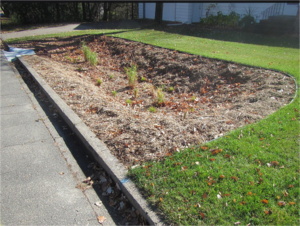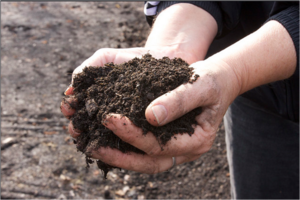
Stormwater and soil, engineered (bioretention) media, and media amendments

Engineered media in a bioretention practice. Image from MPCA's Flickr website.

Compost is an important component of most engineered media mixes. It is also commonly used as an amendment to improve soil properties, such as infiltration rate, fertility, and structure. Image from MPCA's Flickr website.
Information: Engineered media is manufactured from soil (sand, silt, clay) and other components (e.g. compost, iron, etc.), in specific proportions, for a specific application (e.g. green roof, bioretention, tree box). Because engineered media are widely used in bioretention practices, the term "bioretention media" is widely used. We prefer the term "engineered media" as it more accurately describes the applicability of these media.
Soil and engineered media are fundamental design characteristics of most post-construction stormwater practices. Engineered media is a mixture of sand, fines (silt, clay), and organic matter utilized in stormwater practices, most frequently in bioretention practices. The media is typically designed to have a rapid infiltration rate, attenuate pollutants, and allow for plant growth. In some applications, soil or media amendments are utilized to improve soil conditions or enhance treatment effectiveness of a BMP.
This page provides links to pages that address topics related to soil, engineered media, and soil/media amendments.
Soil
- General soil information
- Soil properties and processes
- Managing soils
- Alleviating compaction from construction activities
- Erosion prevention practices
- Sediment control practices
- Stormwater and soil, engineered (bioretention) media, and media amendments
- Guidance for amending soils with rapid or high infiltration rates
- Soil restoration - contents
- Soil contamination - contents
- Soil measurements and methods
- Tabled values
- Soil resources and maps
Engineered media
- General information on media
- Overview of engineered (bioretention) media and applications for stormwater
- Engineered (bioretention) media mixes for stormwater applications
- Phosphorus leaching, export, and retention in engineered (bioretention) media
- MPCA-approved mechanisms and values for removal of dissolved phosphorus from stormwater runoff
- Links to literature pertaining to engineered (bioretention) media
- Engineered (bioretention) media selection tool
- Inorganic materials and amendments
- Organic materials and amendments
- Compost and stormwater management
- Biochar and applications of biochar in stormwater management
- Coir and applications of coir in stormwater management
- Wood chips and applications of wood chips in stormwater
- Peat and applications of peat in stormwater
- Engineered (bioretention) media organic material properties and specifications
- Amendments - general information
- Media in best management practices
- Vegetation
- Links
- May 6 Engineered media meeting
- Meeting recording
- Andy's presentation - File:2020-05-06 AJE Biofiltration.pdf
- May 6 engineered media meeting notes
- May 6 Engineered media meeting
- Photos
- Interesting websites
This page was last edited on 8 February 2023, at 22:24.